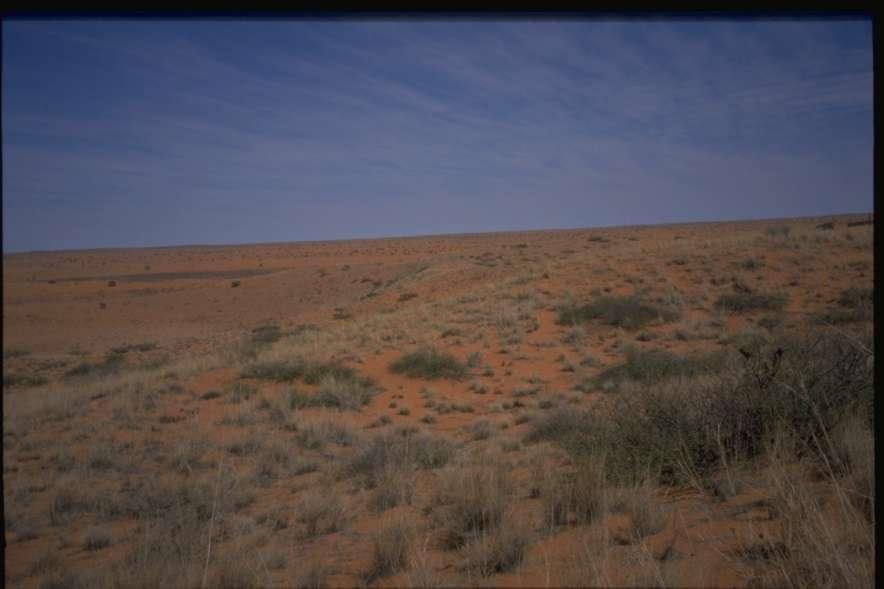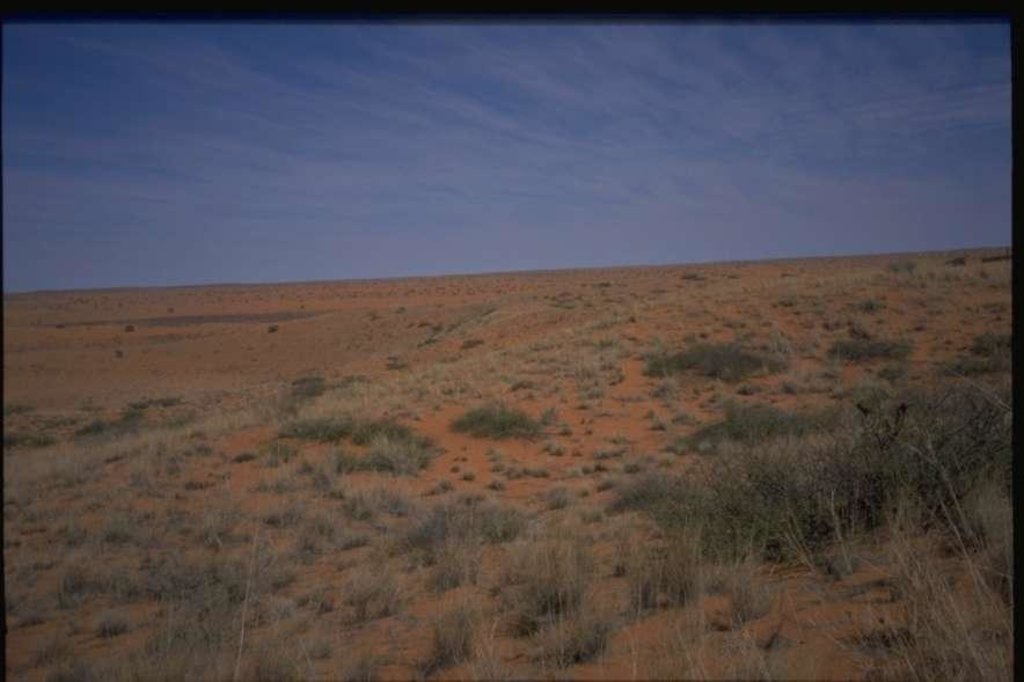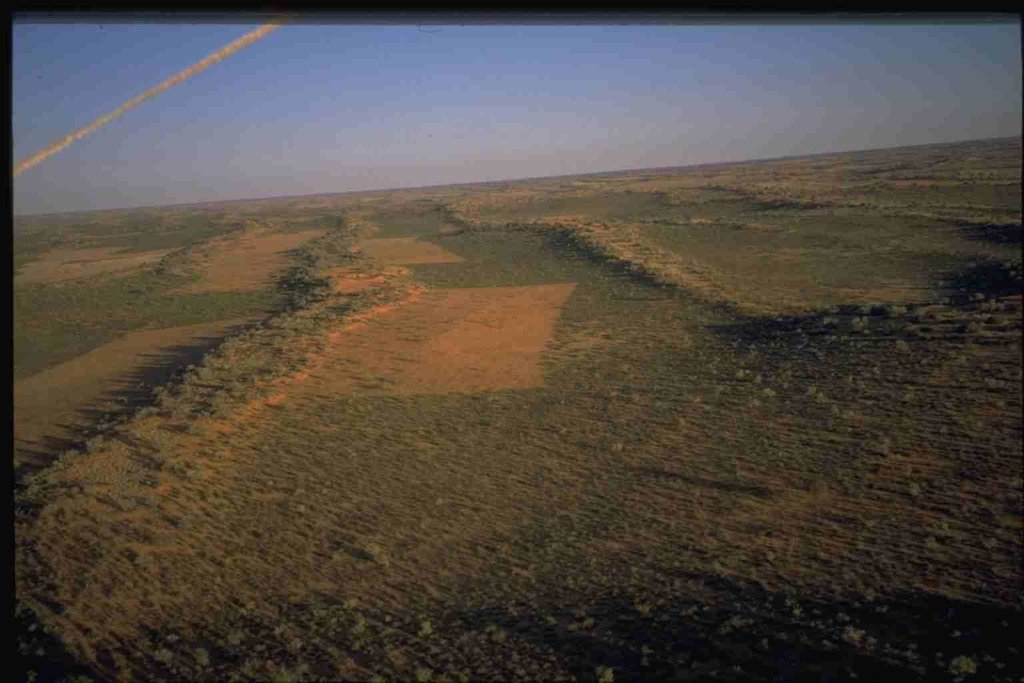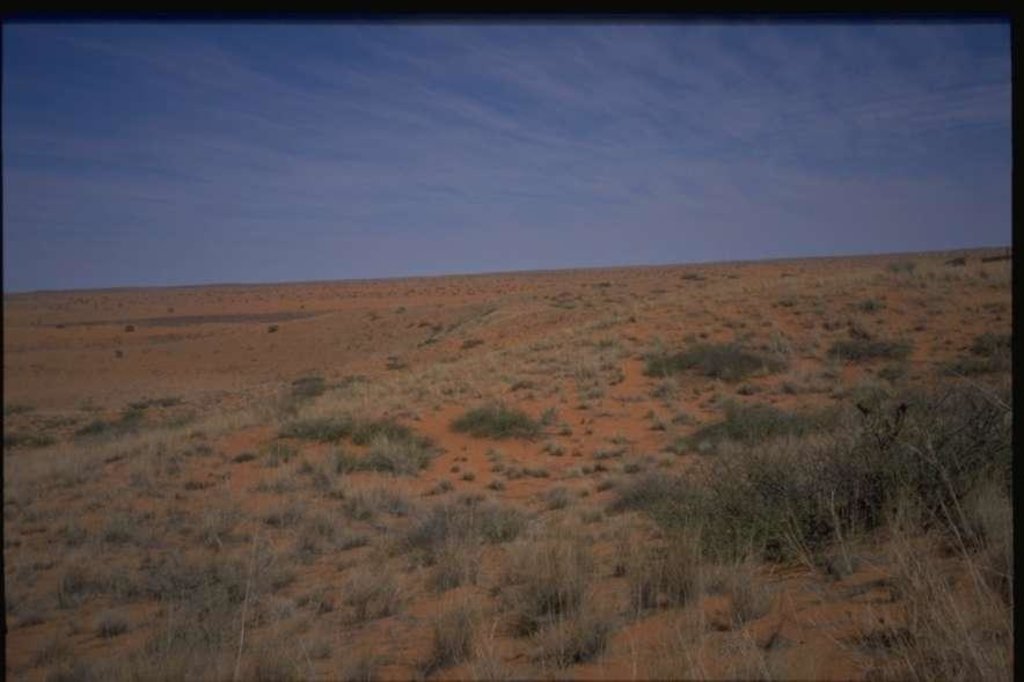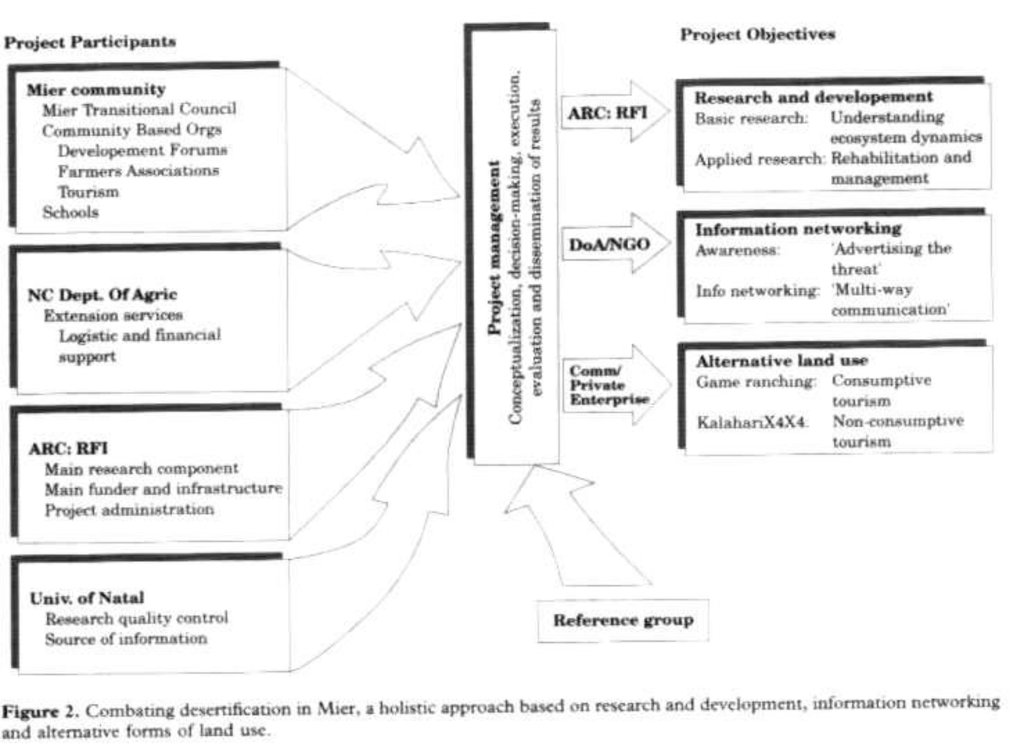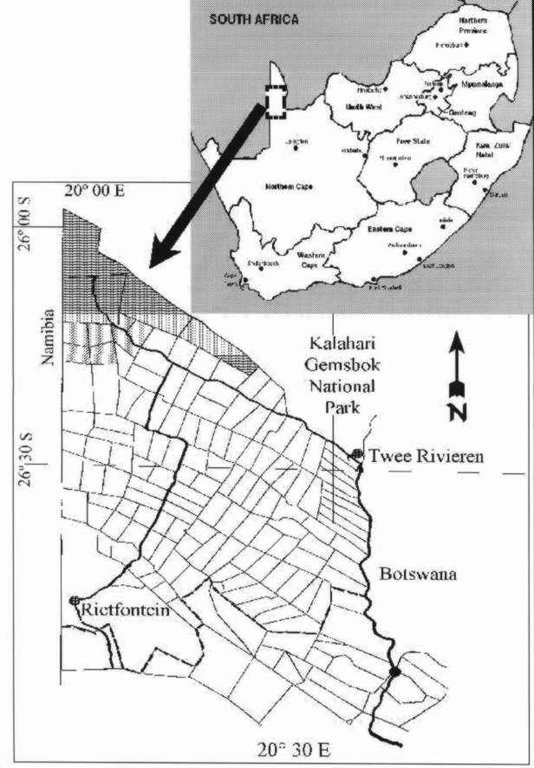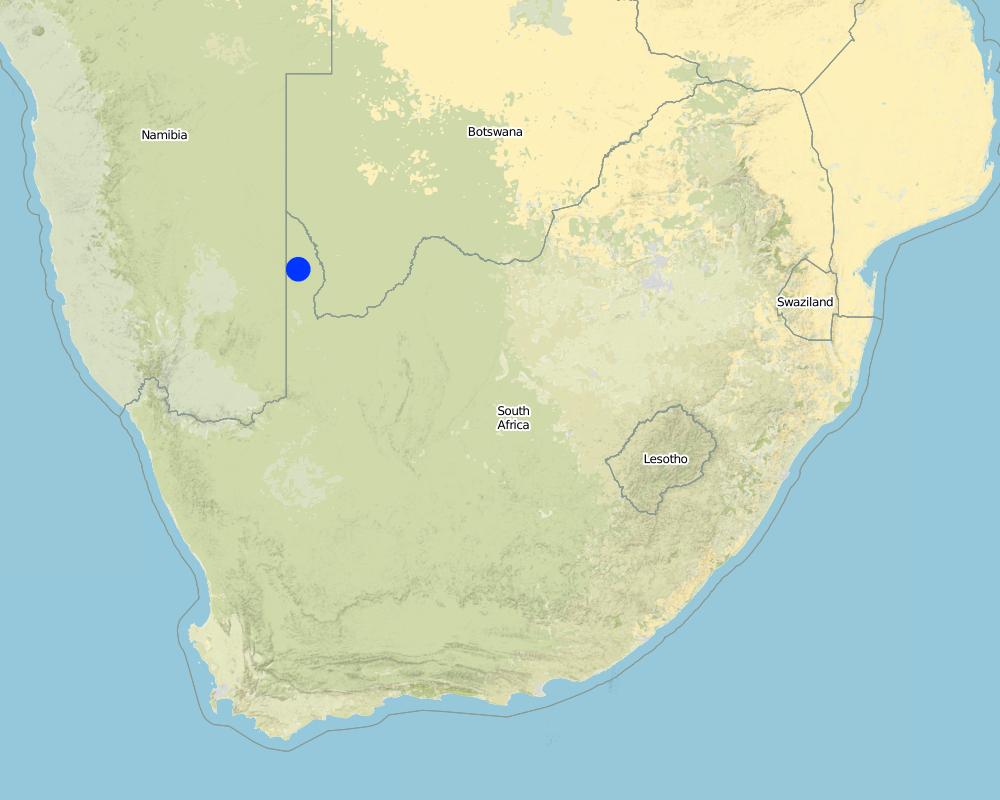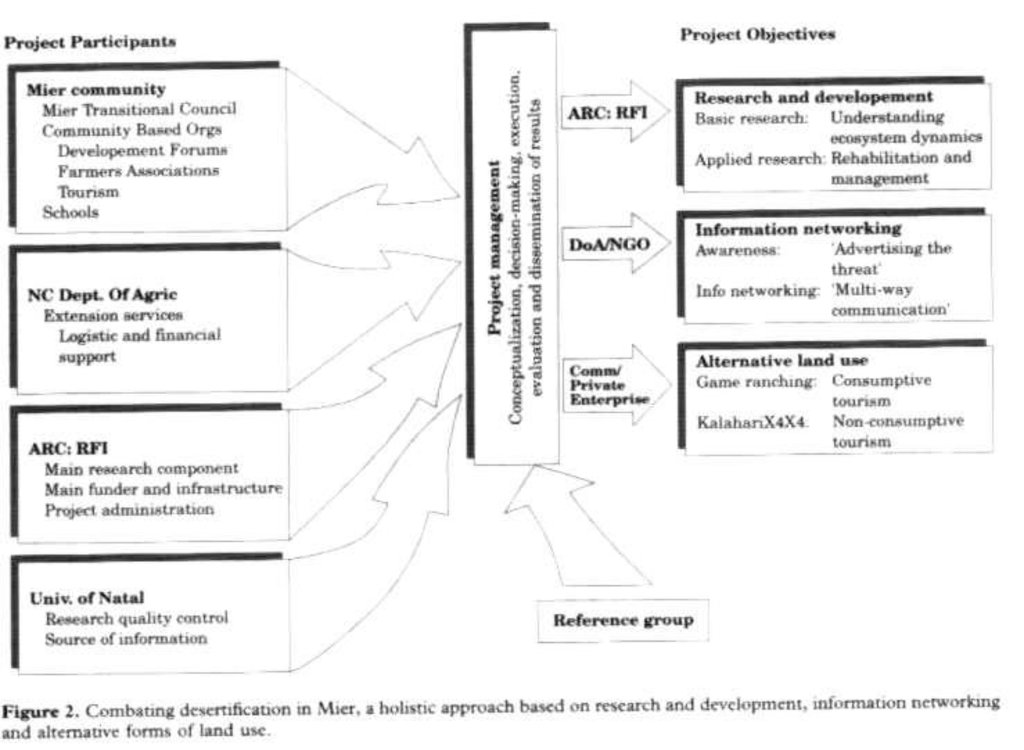Rehabilitation techniques in southern Kalahari - Vegetative and Management [ប្រទេសអាហ្រ្វិកខាងត្បូង]
- ការបង្កើត៖
- បច្ចុប្បន្នភាព
- អ្នកចងក្រង៖ Andre F. Van Rooyen
- អ្នកកែសម្រួល៖ –
- អ្នកត្រួតពិនិត្យ Fabian Ottiger
approaches_2335 - ប្រទេសអាហ្រ្វិកខាងត្បូង
ពិនិត្យមើលគ្រប់ផ្នែក
ពង្រីកមើលទាំងអស់ បង្រួមទាំងអស់1. ព័ត៌មានទូទៅ
1.2 ព័ត៌មានលម្អិតពីបុគ្គលសំខាន់ៗ និងស្ថាប័នដែលចូលរួមក្នុងការវាយតម្លៃ និងចងក្រងឯកសារនៃវិធីសាស្ត្រផ្សព្វផ្សាយ
អ្នកជំនាញឯកទេស SLM:
Smith Desmond
054-4611415
Northern Cape. Department of Agriculture
ប្រទេសអាហ្រ្វិកខាងត្បូង
ឈ្មោះអង្គភាពមួយ (ច្រើន) ដែលបានចងក្រងឯកសារ/ វាយតម្លៃលើវិធីសាស្ត្រផ្សព្វផ្សាយ (បើទាក់ទង)
Dept. of Agriculture, Northern Cape (Dept. of Agriculture, Northern Cape) - ប្រទេសអាហ្រ្វិកខាងត្បូង1.3 លក្ខខណ្ឌទាក់ទងទៅនឹងការប្រើប្រាស់ទិន្នន័យដែលបានចងក្រងតាមរយៈវ៉ូខេត
អ្នកចងក្រង និង(បុគ្គលសំខាន់ៗ)យល់ព្រមទទួលយកនូវលក្ខខណ្ឌនានាទាក់ទងទៅនឹងការប្រើប្រាស់ទិន្នន័យដែលបានចងក្រងតាមរយៈ វ៉ូខេត:
បាទ/ចា៎
2. ការពណ៌នាអំពីវិធីសាស្ត្រផ្សព្វផ្សាយ SLM
2.1 ពណ៌នាសង្ខេបខ្លីពីវិធីសាស្ត្រផ្សព្វផ្សាយ
Shared interest by Mier Management Council and Provincial Department of Agriculture
2.2 ពណ៌នាលម្អិតពិវិធីសាស្ត្រផ្សព្វផ្សាយ
ពណ៌នាលម្អិតពិវិធីសាស្ត្រផ្សព្វផ្សាយ:
Aims / objectives: Initially a combined effort by Department of Agriculture and Mier Management Council to combat degradation of game camps. Directed towards a male dominated farming community, also involving a few females (ages ranging from middle to old age). An objective was to educate towards awareness to degradation and techniques involving the rehabilitation of these areas and the prevention of getting to this state. Also including methods which prevent returning to this state. Initially using farmer???s days - education. Research came later, focussing on understanding the ecology of the area and then to concentrate on rehabilitation techniques. This was later introduced in farmer???s days, school education and education of management council. Stages of implementation: 1) Realisation by management council that veld was degraded. 2) Department of Agriculture requested to assist ??¡§ in the form of trial and error (i.e. resting camps, poisoning of shrubs). 3) Resting of camps showed no improvement, so Department requested assistance from Agricultural Research Council (Range and Forage Institute) to gain understanding of ecology of area. 4) Once understanding gained and techniques developed, education in the form of farmer???s days, school days and management council. Role of participants: 1) Nature Conservation: Initially involved in game number management. 2) Department of Agriculture: Advisory capacity management of techniques. 3) ARC - Research and advisory. 4) Management council ??¡§ labour control. 5) Community - involved through council in decision-making ??¡§ also jobs provided through labour.
2.3 រូបភាពនៃវិធីសាស្ត្រផ្សព្វផ្សាយ
2.5 ប្រទេស/តំបន់/ទីតាំងកន្លែង ដែលវិធីសាស្ត្រផ្សព្វផ្សាយត្រូវបានអនុវត្តន៍
ប្រទេស:
ប្រទេសអាហ្រ្វិកខាងត្បូង
តំបន់/រដ្ឋ/ខេត្ត:
Northern Cape
Map
×2.6 កាលបរិច្ឆេទនៃការចាប់ផ្តើម និងបញ្ចប់នៃវិធីសាស្រ្តផ្សព្វផ្សាយនេះ
សូមបញ្ជាក់ឆ្នាំដែលបានបង្កើតឡើង:
1988
2.7 ប្រភេទនៃវិធីសាស្ត្រផ្សព្វផ្សាយ
- ផ្អែកលើគម្រោង/កម្មវិធី
2.8 គោលបំណង/ទិសដៅសំខាន់នៃវិធីសាស្ត្រផ្សព្វផ្សាយ
The Approach focused mainly on SLM with other activities (Income generation for tax subsidy in the community, job creation for males in the community, land care, development of eco-tourism, collaboration with local leadership)
Education ??¡§ in techniques to combat desertification, also in prevention of degradation Financial empowerment Management techniques
The SLM Approach addressed the following problems: Finance, education (very little education with regards to labours)
2.9 លក្ខខណ្ឌអនុញ្ញាត ឬរារាំងការអនុវត្តន៍បច្ចេកទេសដែលស្ថិតនៅក្រោមវិធីសាស្រ្តផ្សព្វផ្សាយ
ភាពអាចរកបាននៃធនធានហិរញ្ញវត្ថុ និងសេវាកម្ម
- រារាំង
Very poor community
Treatment through the SLM Approach: Landcare (money)
បរិបទនៃស្ថាប័ន
- រារាំង
Financial - no money in Institute and Department
Treatment through the SLM Approach: Money
ក្របខណ្ឌច្បាប់ (សិទ្ធិកាន់កាប់ដីធ្លី កម្មសិទ្ធីប្រើប្រាស់ដីនិងទឹក)
- អំណោយផល
The existing land ownership, land use rights / water rights moderately helped the approach implementation: Hinder: moderate Farm-government won???t allow farmers to own land so attitude can be negative. Community reaps benefits from game farms.
ផ្សេងៗ
- រារាំង
Political: leads to mistrust and uneasiness w.r.t. Money
Treatment through the SLM Approach: Work on the problem at hand and ignore politics
3. ការចូលរួម និងតួនាទីរបស់ភាគីពាក់ព័ន្ធ
3.1 អ្នកពាក់ព័ន្ធដែលបានចូលរួមក្នុងវិធីសាស្ត្រផ្សព្វផ្សាយ និងតួនាទីរបស់ពួកគេ
- អ្នកប្រើប្រាស់ដីក្នុងតំបន់/សហគមន៍
Working land users were mainly men (Women did not work on project because of long distance to work).
Labour, management.
Labour work far too heavy for women (injuries have occurred). Women are directed towards cultivation techniques of Harpagophytum procumbens or basic homeskills (sewing etc.) Males - chopping & packing Rhigozum on dunes (degraded dunes).
- គ្រូបង្រៀន/សិស្សក្មេងៗ/សិស្ស-និស្សិត
- អង្គការក្រៅរដ្ឋាភិបាល
Research, management, education
- រដ្ឋាភិបាលថ្នាក់ជាតិ (អ្នករៀបចំផែនការ អ្នកសម្រេចចិត្ត)
Funding
3.2 ការចូលរួមរបស់អ្នកប្រើប្រាស់ដីក្នុងតំបន់/ សហគមន៍ក្នុងតំបន់ក្នុងដំណាក់កាលផ្សេងគ្នានៃវិធីសាស្រ្តផ្សព្វផ្សាយ
| ការចូលរួមរបស់អ្នកប្រើប្រាស់ដីក្នុងតំបន់/សហគមន៍ក្នុងតំបន់ | សូមបញ្ជាក់នរណាត្រូវបានចូលរួម ព្រមទាំងពណ៌នាសកម្មភាពទាំងនោះ | |
|---|---|---|
| ការចាប់ផ្តើម/ការលើកទឹកចិត្ត | អសកម្ម | workshops/seminars, public meetings; Discussions to indicate where researchers see the project going and how the land users would like to see it go. |
| ការរៀបចំផែនការ | អន្តរកម្ម | workshops/seminars, public meetings; Field workshops & meetings-discuss how and where the project should be carried out. |
| ការអនុវត្តន៍ | ការគាំទ្រពីខាងក្រៅ | responsibility for major steps; Labour used for bushpacking responsibility for LandCare committee for salaries and labour. |
| ការត្រួតពិនិត្យ និងវាយតម្លៃ | គ្មាន | public meetings,measurements/observations, reporting, workshop/seminars; Monitoring of project is on going by researchers with help of few labours. Congresses/workshops are used to describe process & public meetings allow community to be informed. |
| Research | គ្មាន | on-station; On-farm & on-station is ongoing. Lab work for information on germination processes. |
3.3 គំនូសបំព្រួញ (ប្រសិនបើមាន)
3.4 ការសម្រេចចិត្តលើការជ្រើសរើសបច្ចេកទេស SLM
សូមបញ្ជាក់តើអ្នកណាជាអ្នកបានសម្រេចចិត្តក្នុងការជ្រើសរើសបច្ចេកទេសដើម្បីយកមកអនុវត្តន៍:
- អ្នកជំនាញឯកទេស SLM បន្ទាប់ពីបានប្រឹក្សាយោបល់ជាមួយអ្នកប្រើប្រាស់ដី
ចូរពន្យល់:
land user driven (bottom-up). Knowledge of the area
Decisions on the method of implementing the SLM Technology were made by mainly by SLM specialists with consultation of land users. directive (top-down). Management due to low education
4. ជំនួយបច្ចេកទេស ការកសាងសមត្ថភាព និងការគ្រប់គ្រងចំណេះដឹង
4.1 ការកសាងសមត្ថភាព/ បណ្តុះបណ្តាល
តើវគ្គបណ្តុះបណ្តាលបានផ្តល់ឱ្យអ្នកប្រើប្រាស់ដី/អ្នកពាក់ព័ន្ធផ្សេងៗទៀតដែរឬទេ?
បាទ/ចា៎
សូមបញ្ជាក់តើអ្នកណាត្រូវបានបណ្តុះបណ្តាល:
- អ្នកប្រើប្រាស់ដី
- school children/students, planners, politicians/decision makers
ទម្រង់នៃការបណ្តុះបណ្តាល:
- ពីកសិករទីកសិករ
- ទីតាំងបង្ហាញ
ប្រធានបទបណ្តុះបណ្តាល:
Rehabilitation ecological processes, cultivation, preventative agriculture
4.2 សេវាផ្តល់ប្រឹក្សាយោបល់
តើអ្នកប្រើប្រាស់ដីបានទទួលនូវសេវាផ្តល់ប្រឹក្សាដែរ ឬទេ?
បាទ/ចា៎
សូមបញ្ជាក់ប្រសិនបើសេវាកម្មប្រឹក្សាយោបល់ត្រូវបានផ្តល់ឱ្យ:
- នៅលើដីរបស់អ្នកប្រើប្រាស់ដី
- នៅមជ្ឈមណ្ឌលជាអចិន្ត្រៃ
ពណ៌នា/ពន្យល់:
Name of method used for advisory service: Not formal approach; Key elements: Education, Labour, Development; 1) Advisory service was carried out through: government's existing extension system Extension staff: mainly government employees 3) Target groups for extension: land users, school children/students; Activities: Bushpacking techniques, education; Education
Advisory service is inadequate to ensure the continuation of land conservation activities; The project is still in first phase - next phase will include female portion of community.
4.3 ការពង្រឹងសមត្ថភាពស្ថាប័ន (ការអភិរឌ្ឍន៍អង្គភាព)
តើស្ថាប័នទាំងអស់ត្រូវបានបង្កើតឡើង ឬពង្រឹងសមត្ថភាពតាមរយៈវិធីសាស្ត្រផ្សព្វផ្សាយដែរ ឬទេ?
- បាទ/ច៎ា តិចតួច
សូមបញ្ជាក់ថាតើស្ថាប័នត្រូវបានពង្រឹង ឬបង្កើតឡើងនៅត្រឹមកម្រិតណា(ច្រើន)?
- ថ្នាក់មូលដ្ឋាន
សូមបញ្ជាក់ប្រភេទនៃការគាំទ្រ:
- សម្ភារៈ
- advise
4.4 ការត្រួតពិនិត្យ និងវាយតម្លៃ
តើការត្រួតពិនិត្យ និងវាយតម្លៃគឺជាផ្នែកមួយនៃវិធីសាស្ត្រដែរឬទេ?
បាទ/ចា៎
មតិយោបល់:
bio-physical aspects were regular monitored through measurements
technical aspects were ad hoc monitored through observations
socio-cultural aspects were ad hoc monitored hrough observations
economic / production aspects were regular monitored through measurements
area treated aspects were regular monitored through measurements
no. of land users involved aspects were ad hoc monitored through observations
management of Approach aspects were ad hoc monitored through observations
There were few changes in the Approach as a result of monitoring and evaluation: Packing designs of Rhigozum plants on bare dunes. The less expensive, most efficient design was chosen.
4.5 ការស្រាវជ្រាវ
តើការស្រាវជ្រាវ គឺជាផ្នែកមួយនៃវិធីសាស្រ្តដែរឬទេ?
បាទ/ចា៎
បញ្ជាក់ប្រធានបទ:
- បរិស្ថានវិទ្យា
សូមផ្តល់ព័ត៌មានបន្ថែមទៀតឱ្យបានលម្អិត និងចង្អុលបង្ហាញនរណាដែលបានធ្វើការស្រាវជ្រាវ:
Rehabilitation techniques must fall within the capabilities and finance of the community.
Research was carried out on-farm
5. ថវិកា និងសម្ភារៈឧបត្ថម្ភពីខាងក្រៅ
5.1 ថវិកាប្រចាំឆ្នាំសម្រាប់ផ្សព្វផ្សាយ SLM
មតិយោបល់ (ឧ. ប្រភពសំខាន់នៃមូលនិធិ/ម្ចាស់ជំនួយចំបង):
Approach costs were met by the following donors: government (national): 80.0%; local community / land user(s) (-): 20.0%
5.2 ការគាំទ្រផ្នែកហិរញ្ញវត្ថុ / សម្ភារៈដែលបានផ្តល់ទៅឱ្យអ្នកប្រើប្រាស់ដី
តើអ្នកប្រើប្រាស់ដីបានទទួលការគាំទ្រផ្នែកហិរញ្ញវត្ថ/សម្ភារៈសម្រាប់ការអនុវត្តន៍បច្ចេកទេសដែរឬទេ:
បាទ/ចា៎
5.3 សូមបញ្ជាក់ពីធាតុចូលត្រូវបានផ្តល់បដិភាគ (រួមទាំងកម្លាំងពលកម្ម)
- សម្ភារៈ
| សូមបញ្ជាក់ ធាតុចូលណាខ្លះដែលបានផ្តល់បដិភាគ | កម្រិតទំហំប៉ុណ្ណា | សូមបញ្ជាក់ពីការបដិភាគ |
|---|---|---|
| ម៉ាស៊ីន | ផ្តល់ហិរញ្ញវត្ថុទាំងស្រុង | |
| ឧបករណ៍ | ផ្តល់ហិរញ្ញវត្ថុទាំងស្រុង | |
- កសិកម្ម
| សូមបញ្ជាក់ ធាតុចូលណាខ្លះដែលបានផ្តល់បដិភាគ | កម្រិតទំហំប៉ុណ្ណា | សូមបញ្ជាក់ពីការបដិភាគ |
|---|---|---|
| គ្រាប់ពូជ | ផ្តល់ហិរញ្ញវត្ថុទាំងស្រុង | |
| ជី | ផ្តល់ហិរញ្ញវត្ថុទាំងស្រុង | |
- ផ្សេងៗ
| ផ្សេងៗ (បញ្ចាក់) | កម្រិតទំហំប៉ុណ្ណា | សូមបញ្ជាក់ពីការបដិភាគ |
|---|---|---|
| Food and transport | ផ្តល់ហិរញ្ញវត្ថុទាំងស្រុង |
ប្រសិនបើកម្លាំងពលកម្មធ្វើដោយអ្នកប្រើប្រាស់ដី តើវាជាធាតុចូលដ៏សំខាន់មួយដែរ ឬទេ:
- បង់ជាសាច់ប្រាក់
6. ការវិភាគរកផលប៉ះពាល់ និងសេចក្តីសន្និដ្ឋាន
6.1 ផលប៉ះពាល់នៃវិធីសាស្ត្រផ្សព្វផ្សាយ
តើវិធីសាស្ត្រផ្សព្វផ្សាយជួយអ្នកប្រើប្រាស់ដីដើម្បីអនុវត្តន៍ និងថែទាំបច្ចេកទេស SLM?
- ទេ
- បាទ/ច៎ា បន្តិចបន្តួច
- បាទ/ច៎ា ជាមធ្យម
- បាទ/ច៎ា បានខ្លាំង
Stabilisation of dunes, greater vegetation on dunes.
តើវិធីសាស្ត្រផ្សព្វផ្សាយបានឱ្យប្រសើរឡើងនូវបញ្ហាកាន់កាប់ដីធ្លី/សិទ្ធិអ្នកប្រើប្រាស់ដែលរារាំងដល់ការអនុវត្ត SLM?
- ទេ
- បាទ/ច៎ា បន្តិចបន្តួច
- បាទ/ច៎ា ជាមធ្យម
- បាទ/ច៎ា បានខ្លាំង
Farmers realised the simplicity of rehabilitation. The problem is likely to be overcome in the near future. Attitudes would change if government allowed ownership of land.
Did other land users / projects adopt the Approach?
- ទេ
- បាទ/ច៎ា បន្តិចបន្តួច
- បាទ/ច៎ា ជាមធ្យម
- បាទ/ច៎ា បានខ្លាំង
South Africa railways - lines which cut through dune systems
6.3 សកម្មភាពផ្សព្វផ្សាយដែលប្រកបដោយចីរភាព
តើអ្នកប្រើប្រាស់ដីអាចធ្វើឱ្យមានចីរភាពនូវអ្វីដែលត្រូវបានអនុវត្តន៍តាមរយៈវិធីសាស្ត្រផ្សព្វផ្សាយដែរឬទេ(ដោយពុំមានការគាំទ្រពីអ្នកខាងក្រៅ)?
- បាទ/ចា៎
6.4 ភាពខ្លាំង/ គុណសម្បត្តិនៃវិធីសាស្ត្រផ្សព្វផ្សាយ
| ភាពខ្លាំង/ គុណសម្បត្តិ/ ឱកាស ទស្សនៈរបស់អ្នកប្រើប្រាស់ដី |
|---|
| Own input into R &D |
| ភាពខ្លាំង/ គុណសម្បត្តិ/ ឱកាស ទស្សនៈរបស់បុគ្គលសំខាន់ៗ |
|---|
| Community participation (How to sustain/ enhance this strength: Greater responsibility to community) |
| Healthy integration of Scientists & Community action (How to sustain/ enhance this strength: Good communication (Scientists & Community)) |
6.5 ភាពខ្សោយ/ គុណវិបត្តិនៃវិធីសាស្ត្រ និងរកដំណោះស្រាយ
| ភាពខ្សោយ/ គុណវិបត្តិ/ ហានិភ័យ ទស្សនៈរបស់អ្នកប្រើប្រាស់ដី | តើបច្ចេកទេសទាំងនោះបានដោះស្រាយបញ្ហាដូចម្តេច? |
|---|---|
| I do not know |
| ភាពខ្សោយ/ គុណវិបត្តិ/ ហានិភ័យក្នុងទស្សនៈរបស់បុគ្គលសំខាន់ៗ | តើបច្ចេកទេសទាំងនោះបានដោះស្រាយបញ្ហាដូចម្តេច? |
|---|---|
| Slow recovery of natural resources | I don't think there is a way to increase reaction time in this area |
7. ឯកសារយោង និងវេបសាយ
7.1 វិធីសាស្ត្រ/ ប្រភពនៃព័ត៌មាន
- តាមការចុះទីវាល ការស្រាវជ្រាវនៅទីវាល
- ការសម្ភាសន៍ជាមួយអ្នកប្រើប្រាស់ដី
ការតភ្ជាប់ និងម៉ូឌុល
ពង្រីកមើលទាំងអស់ បង្រួមទាំងអស់ការតភ្ជាប់
គ្មានការតភ្ជាប់
ម៉ូឌុល
គ្មានម៉ូឌុល


